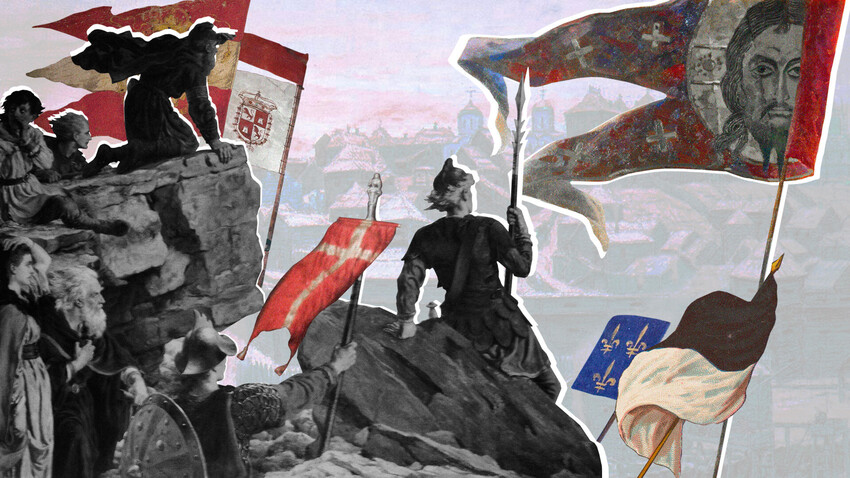
Even before the Posolsky Prikaz – the first Russian foreign policy office – was established in 1549, the Grand Duchy of Moscow – also known as Muscovite Russia – started to build diplomatic relations with other states. Some of these relations were rocky, but survived the test of time.
The first European state Moscow established regular diplomatic relations with was the Holy See, a political entity under the Pope’s jurisdiction. Pope’s envoys came in contact with Vladimir the Great – who ruled the Kievan Rus’ – as early as 988. Since then, Holy See-Russia relations have solidified.

Vladimir the Great converse about faith with envoys from Rome.
Public domainFrom the early 13th century, the correspondence between Moscow and the Holy See intensified and Pope envoy’s visits to Moscow became regular. During the reign of Peter the Great in Russia in the late 17th and early 18th century, Moscow was interested in the Pope’s stance on the election to the Polish throne, while the Holy See hoped to secure the Russian ruler’s agreement for building a Catholic monastery in Moscow and opening Russian territories for Catholic missionaries heading to China.
In 1481, Moscow established diplomatic relations with Denmark, a historically friendly state. Then Moscow signed treaties of alliance with the Kingdom of Hungary and the Venetian Republic in 1485.
In 1487, the Grand Duchy of Moscow and the Kingdom of Poland – two generally hostile states – engaged in irregular diplomatic communication, but fell short of establishing regular diplomatic relations.
The Russians traditionally had better relations with distant European states than with their immediate neighbors like the Kingdom of Poland, for example. That said, in the first two decades of the 1500s, Moscow came in contact with representatives of Spain, the Kingdom of Sweden, Prussia, France and the Hanseatic League – a medieval commercial and defensive confederation of merchant guilds and market towns in Central and Northern Europe.
The Crimean Khanate became the first Eastern state Moscow established diplomatic relations with. Overall, the Russians sought to establish first stable diplomatic relations with those countries in the East that often posed some danger to its security or had the potential to challenge its interests.

A letter from the Crimean Khan Mengli Girey to the Grand Prince of Moscow Ivan III in 1474 proclaimed the khan’s friendship, unity against common enemies and unwillingness to attack or conquer the lands and principalities belonging to the state of Moscow.
In 1489, Moscow ruler Ivan III signed a treaty on friendship and unity with the khan of the Nogai Horde, a confederation founded by nomads that occupied the Pontic–Caspian steppe. However, diplomatic contacts between the two states remained rare: The tsar’s envoys only paid visits to the Nogai Horde only in case of emergencies to negotiate coalitions or requests to send cavalry to back up the tsarist army.
Diplomatic relations with one of Moscow’s most bitter historic enemies – the Ottoman Empire – were established in 1492, when Russian ruler Ivan III and Sultan Bayezid II attempted to improve trade and security relations between the two historically hostile states.
After the first Russian foreign policy office known as Posolsky Prikaz – a governmental institution in Russia in 1549-1720 in charge of relations with foreign countries – was established in 1549, the process of maintaining diplomatic relations with foreign states became formally institutionalized.

"Foreign Envoys at the Ambassador's Office" by B. Schwartz, (1867).
Historical MuseumDifferent divisions within the Prikaz were formed and tasked with handling regular diplomatic relations between Russian rulers and their foreign counterparts.
For example, in the early 1680s, five divisions within the Prikaz were formed. Each division was responsible for handling relations and correspondence with various groups of states: one for the Holy See, Spain, France and England; another for Sweden, Poland, Wallachia, Moldavia, Turkey, Crimea, Holland, Hamburg and the Hanseatic cities; another for Denmark and Brandenburg; another for Persia, Armenia and India; and the last one for China, Bukhara, Khiva and Georgia.
Dear readers,
Our website and social media accounts are under threat of being restricted or banned, due to the current circumstances. So, to keep up with our latest content, simply do the following:
If using any of Russia Beyond's content, partly or in full, always provide an active hyperlink to the original material.
Subscribe
to our newsletter!
Get the week's best stories straight to your inbox